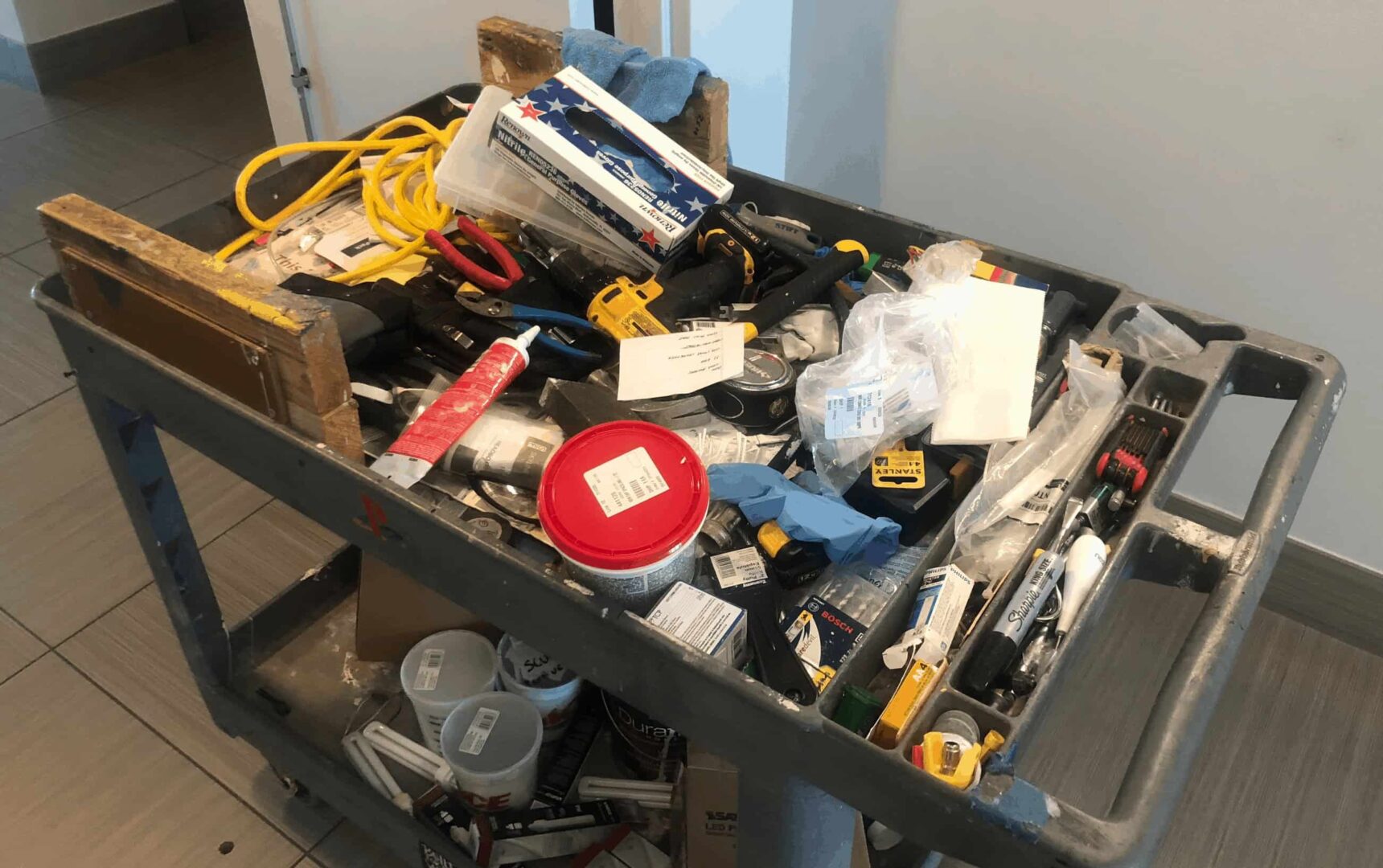I got onto the elevator in the lobby of our condo building one day last week. Our building's maintenance guy was already on there with a rolling cart of tools and supplies. I asked him to let me hop on with him and said, “Good morning.”
I looked at the cart and said,
“That looks a cart that says it's a busy day ahead.”
I don't know, I bet they're all busy days, but I was trying to compliment him, in my awkward way, that he does a lot for the building. The other day, I had thanked him for all that he does and I meant it.
The top surface of cart didn't appear to be very organized:

I wasn't trying to be critical.
His response was,
“Yeah, it's pretty messy. Sometimes I organize it and a few days later, it's like this.”
Scroll down or keep reading for the rest of his comments…
The cart didn't bother me. That might surprise you. I've always said that “5S” and “workplace organization” tactics are MORE beneficial when you have shared workspaces. For example, 5S is probably more beneficial in a shared nurses station than it is in the nurse manager's desk.
Our maintenance guy isn't practicing 5S or Lean. He's just thinking and making his work easier — and that's the core of Lean anyway.
When people share a workspace, it's more important for items and tools to be returned to their “home location.” This prevents wasted time and motion spent searching for things. For an individual desk, unless it's sooooo messy that the sole user of the desk can't find things, I'm not a stickler for 5S… in fact, that's why I tend to agree that mandated “office 5S” initiatives can cause problems than they solve.
In hospitals, since patients are being harmed (and are dying) due to preventable medical errors, I think the Taiichi Ohno principle of “start from need” and focusing on “your most pressing needs” would suggest that solving patient safety problems is a higher priority over dictating how many pens can be in the drawers of the nurses' station.
Office 5S initiatives led to me creating this video:
Is it bad to be organized? Of course not. But I think it's better when it's self-initiated and/or it serves a meaningful purpose. I don't criticize people who CHOOSE to 5S their desk or use shadowboards… but I will criticize organizations that MANDATE desk 5S in a way that just antagonizes people.
Back to our condo maintenance guy… what's the point of 5S or him organizing his tool cart?
I'd argue that improvements that he might make to his work should focus on:
- Improving his safety
- Improving his productivity
- Improving the quality of his work
Things like that. If he's better organized, he can probably do more jobs per day, and the quality would probably be better if he's not rushing or under time pressure.
His next comment was brilliant:
“But having everything on the cart is a huge time saver.”
He realizes that it would be a huge waste of his time to be constantly walking (and elevatoring) down to the ground floor maintenance area and back all day long.
He's focusing on having the right stuff with him, in the right place, and at the right time.
I'd much rather see a messy tool cart on wheels instead of seeing a “perfectly 5S-ed” table in the maintenance area. What's the point of tape outlines and shadowboards if you're constantly walking back and forth to them all day.
It's not an either/or, I realize. You could have an organized office/storage area and a point-of-use that's also well organized. But, our maintenance guy has found what works well enough for his situation.
Maybe Lean is common sense, as some people say. Or is this scenario common sense to him?
Many aspects of Lean are, in fact, counterintuitive (such as the benefits of smaller batch sizes).
Here's one more old post about whether Lean is “obvious” or not. Sometimes, it only seems obvious in hindsight.
Thanks for reading. What do you think?
What do you think? Please scroll down (or click) to post a comment. Or please share the post with your thoughts on LinkedIn – and follow me or connect with me there.
Did you like this post? Make sure you don't miss a post or podcast — Subscribe to get notified about posts via email daily or weekly.
Check out my latest book, The Mistakes That Make Us: Cultivating a Culture of Learning and Innovation:










He’s been promoted to be manager at another building. Congrats! Although we will miss him…
Hi Mark,
I am working on 5S for my green belt project at URI. Your blog helped me understand that 5s is best when implemented for shared work stations. you also highlighted that 5s should not create problems when it is being implemented to fix problems. Thank you!
I’m glad this post helped you. There’s a photo missing that I need to restore later. So please check back tomorrow for that, Sean. Best wishes to you in your studies and your belt project.